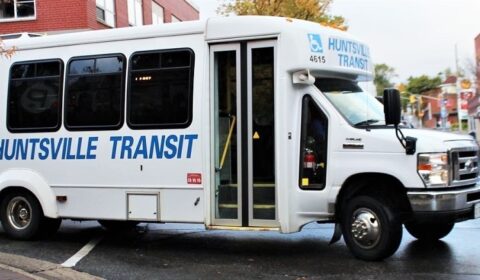HUNTSVILLE TRANSIT PLAN GETS $122,000 BOOST FROM ONTARIO
Mark Clairmont | MuskokaTODAY.com
HUNTSVILLE — Urban sprawl in Muskoka’s largest and fastest-growing municipality is forcing the Town of Huntsville to expand its bus transit service to increase ridership.
And the province is helping them “get people moving” by investing in new transit projects, including new plans here.
As part of the per litre gas tax that each driver pays on every vehicle fill-up, governments transfer a portion of those dollars back to local governments.
This year, Huntsville received $124,632 and Bracebridge $109,438 from the province.
Gravenhurst does not have public transit.
Now, Huntsville could receive an almost equal amount from the province.

MPP Norman Miller announced Thursday that Phase 1 of Huntsville’s Ridership Growth Plan is being nominated under the Public Transit stream of the Investing in Canada Infrastructure Program (ICIP).
If approved by the federal government, Ontario would contribute $122,487 (one third) toward the estimated $367,500 cost of the project.
“Public transit is very limited in our area so this project is important because it will allow people who don’t have a car or can’t drive increased access to transit in Huntsville,” said Miller in a release Aug. 8, 2019.
“This will help both residents and local businesses whose employees need transit to get to work.”
Huntsville’s Ridership Growth Plan is intended to expand the service and cut the travel time in order to make it practical for people to use transit to get to and from work.
“Our transit Ridership Growth Plan in Huntsville is about making our community more accessible for all citizens. These changes will improve the efficiency and frequency of our system while expanding the service area,” said Huntsville Mayor Scott Aitchison. “The support of the Province of Ontario for this project is great news for our environment, our community and accessibility.”
The initiatives come as governments at all levels struggle with whether to fund debatable urban sprawl or invest dollars more wisely closer to home in intensification community building nearer their core.
In announcing annual 2018-19 money in January, to 107 municipalities, the province said funding for Ontario’s gas tax program is determined by the number of litres of gasoline sold in the province.
The program provides municipalities with two cents per litre of provincial gas tax revenues.
Municipalities receiving gas tax funding must use these funds towards their public transit capital and/or operating expenditures, at their own discretion, including upgrading transit infrastructure, increasing accessibility, purchasing transit vehicles, adding more routes and extending hours of service.
The City of Toronto will receive $185 million this year to improve transit projects, such as the TTC,” said Jeff Yurek, who was then transporation minister.
Today, Yurek is minister of environment.
The share that each municipality receives under Ontario’s gas tax program is based on a formula of 70 per cent ridership and 30 per cent population. These funds serve both the needs of large and small municipal transit systems.
Orillia receives $548,000 from the fund and North Bay $895,000.
